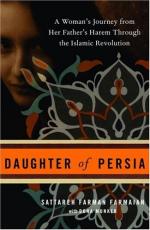|
This section contains 495 words (approx. 2 pages at 400 words per page) |

|
Daughter of Persia: A Woman's Journey from Her Father's Harem Through the Islamic Revolution Summary & Study Guide Description
Daughter of Persia: A Woman's Journey from Her Father's Harem Through the Islamic Revolution Summary & Study Guide includes comprehensive information and analysis to help you understand the book. This study guide contains the following sections:
This detailed literature summary also contains Topics for Discussion on Daughter of Persia: A Woman's Journey from Her Father's Harem Through the Islamic Revolution by Sattareh Farmanfarmaian.
This memoir intertwines two sagas, the political history of Iran and the personal history of the Farman Farmaian family as daughter Satti establishes the country's first college training social workers. Despite Satti's efforts to improve the lives of the poor villagers throughout Iran, when the Ayatollah Khomeini took power, she was arrested and almost executed. After she won her freedom, Satti had no choice but to leave her beloved Iran and the college she founded, to build a new life in the U.S.
Satti grew up in her mother's house within the harem of the family compound in Tehran, the capital city of Iran. Her father, Shazdeh, was over 60 when Satti was born. Each of his seven living wives has her own house, with four within the compound and one next door. The other wives were scattered throughout the countryside. Her father's well-appointed house dominated the compound, although it was far less sumptuous than the homes of his first wife and her sons, next door. Shazdeh's first wife was a royal princess, the daughter of the king. Shazdeh was a general and a politically progressive cousin of the royal family, supporting democracy, the Iranian constitution and education, even for women.
Sattti earned a master's degree in Social Work from the University of Southern California. After working for the U.N. in Iraq a few years, she returned to Iran and opened the nation's first college training social workers. She devoted all of her efforts to building the school, which eventually graduated hundreds of students each year. Satti convinced the Shah's wife and government officials to support the school, which improved the lives of poor people by education on family planning, health care, childcare, nutrition, sanitation and disease prevention.
During the revolution that ousted the Shah of Iran and brought the Ayatollah Khomeini to power, Satti was arrested on fabricated charges. She proved herself innocent of all but one, traveling to Israel 20 years ago to present a paper at a conference. In an Iran controlled by conservative Muslims, that is enough to brand her a traitor. Satti found she must flee the country or face execution.
The personal drama is set against Iran's political turmoil. Although Satti's family were distant cousins of the Shah, they did not support his repressive regime. The Shah's father confiscated many of their houses and much of their land, considering the family his enemies. Satti's second cousin Dr. Mossadegh was Premiere for a time, but a coup funded by the American CIA returned the young Shah of Iran to power. Despite his good reputation in the U.S., the Shah was a ruthless and corrupt dictator who controlled the country with his secret police. The entire Farman Farmaian family opposed him. Still, when the Ayatollah took power, everyone wealthy or educated in the west was considered a traitor. Despite her many years of helping the poorest citizens of Iran, Satti fled in fear for her life.
Read more from the Study Guide
|
This section contains 495 words (approx. 2 pages at 400 words per page) |

|



